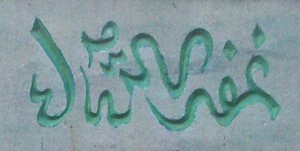Beijing bi-literacy, continued
 Syz recently posted an image from a gravestone in Beijing. Emblazoned atop the stone was a word in Arabic, written in what is known in Arabic as Sini script (خط صيني) which really just means Chinese script. The calligraphic style is found throughout China anywhere Hui Muslims live. It ornaments mosques and memorials as mentioned, but also restaurants and the grill of your local chuarwalla.
Syz recently posted an image from a gravestone in Beijing. Emblazoned atop the stone was a word in Arabic, written in what is known in Arabic as Sini script (خط صيني) which really just means Chinese script. The calligraphic style is found throughout China anywhere Hui Muslims live. It ornaments mosques and memorials as mentioned, but also restaurants and the grill of your local chuarwalla.
In the case of Syz’s photo, the script lends a particularly Islamic touch to a gravestone that might otherwise be missed as that of a Muslim.
The Arabic reads غُفْرَانَك ġufrānak, from the verb root غفر ġ-f-r meaning to forgive, with ان -an- marking it as a verb and ك -k marking it as second person possessive, thus translating as “Your forgiveness”, as in “begging Your”. The “You” in this case refers to God. In other words, please, God, forgive me for any mis-steps I may have taken in my life. The root shows up as well in the common phrase إستغفاراللَّه. But enough on Arabic morphology. Permit me a a quick digression into the realms of theology and identity.
There’s this notion among Muslims worldwide that Arabic is the language of God. This because it is the language of the Qur’an and regardless of if this is or is not the case (i.e. it being the language of God), you can’t argue against the notion existing among many Muslims. It’s like Latin to Catholicism in the post-Vatican II world.
As a result we see Arabic thrown around in this way, despite the fact that the person upon whose gravestone it sits may have had very little understanding of the language. Every Uyghur restaurant in Shanghai has بسم الله الرحمن الرحيم written above the door, as do Hui and faux-Hui restaurants. Sini calligraphy is framed on the walls of every Huí Huí Guōtiē 回回锅贴¹ where not a one of the servers knows which set of syllables links to which collection of squiggles.
 I remember a lunch with a Syrian gentlemen in Nanjing a few years back. He was lamenting the state of Islamic education in China, where even during Ramadan the workers at the local Hui 兰州拉面² restaurant were kicking back at noon with glasses of Jīnlíng Píjiǔ 金陵啤酒³. White caps make for good noodle business, plain and simple.
I remember a lunch with a Syrian gentlemen in Nanjing a few years back. He was lamenting the state of Islamic education in China, where even during Ramadan the workers at the local Hui 兰州拉面² restaurant were kicking back at noon with glasses of Jīnlíng Píjiǔ 金陵啤酒³. White caps make for good noodle business, plain and simple.
We’ve written here before about Foreign being written on packaging. I’ve written about Arabic in particular. But this is something different. Here it’s a quiet enforcement of group identity in a place where non-Han group identity isn’t exactly embraced.
They could have written something like 求祢饶恕我的过错. That would have communicated something to the passers-by. But this was never about the passers-by.
شكرا لك يا إسراء لمساعدة
– – –
1. The best guotie dumpling restaurant in the world. Only in Jiangsu Changhzou.
2. Lánzhōu lāmiàn. That “Muslim” noodle joint you pass on the way to class.
3. Nanjing’s locally made beer, Jinling being the name of the city under the Chǔ (楚國)
I love reading these posts about Beijing bi-literacy. Anyway, just wanted to say your footnote about “Lanzhou lamian” was hilarious. My friends and I loved our local “Muslim” noodle shop. We went there all the time! The guys who worked there were pretty young, and always seemed serious when we came by, so our goal while living there was to make them smile. We finally managed to near the end of our stay. Best noodles in the world.